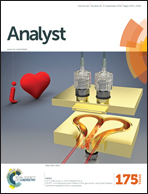The correction fluorescence inner filter effect using a single excitation and dual-emission fiber optic probe
Abstract
A significant disadvantage of fluorometry is the inner filter effect when the fluorophore concentration is high. A new simple fiber-optic probe was made to measure the concentration of fluorescent solutions. The proposed probe consists of one excitation fiber and two emission fibers. One emission fiber is parallel to the excitation fiber, and the other has a tilted angle with the excitation fiber. A numerical model was used to optimize the tilted angle and distance of the three fibers. There was a linear relationship between the fluorophore concentration and the ratio of the fluorescence intensity of the two emission fibers. Using our homemade probe, we measured Eosin Y, fluorescein and quinine sulfate solutions. The linear range of Eosin Y solution was up to 500 μM, which was approximately 7 times the range measured with a single emission probe. The results of fluorescein and quinine sulfate solutions also showed that the fluorescence intensity ratio method could correct the inner filter effect. The experimental results also indicated that the probe is robust when the excitation light fluctuates.


 Please wait while we load your content...
Please wait while we load your content...